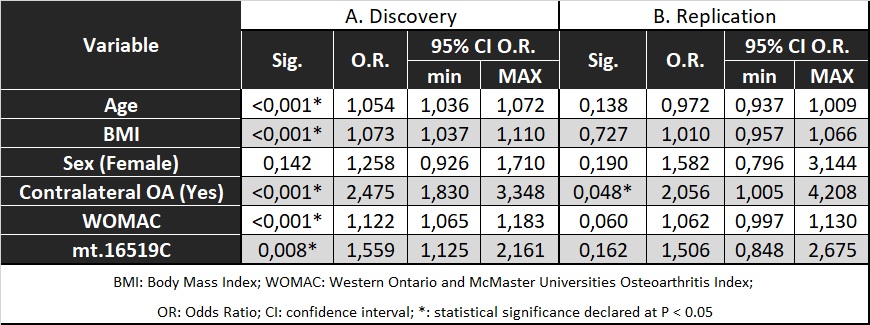Back
Poster Session C
Genetics, genomics and proteomics
Session: (1118–1149) Genetics, Genomics and Proteomics Poster
1149: A Novel Mitochondrial Variant as a Predictor for the Rapid Progressive Knee Osteoarthritis Phenotype: Development of a Predictive Model and Functional Studies
Sunday, November 13, 2022
1:00 PM – 3:00 PM Eastern Time
Location: Virtual Poster Hall

Alejandro Durán-Sotuela, BSc, MSc
Fundacion Profesor Novoa Santos
A Coruña, Spain
Abstract Poster Presenter(s)
Alejandro Durán-Sotuela1, Mercedes Fernández-Moreno1, Tamara Hermida-Gómez1, Sara Relaño1, Victoria Suárez-Ulloa2, vanesa Balboa-Barreiro3, Natividad Oreiro1, Jorge Vázquez-García1, FJ Blanco1 and Ignacio Rego-Pérez1, 1Servicio de Reumatología. Instituto de Investigación Biomédica de A Coruña (INIBIC). Complexo Hospitalario Universitario de A Coruña (CHUAC), Sergas. Universidade da Coruña (UDC), A Coruña, Spain, 2Plataforma de Bioinformática. Instituto de Investigación Biomédica de A Coruña (INIBIC). Complexo Hospitalario Universitario de A Coruña (CHUAC), Sergas. Universidade da Coruña (UDC), A Coruña, Spain, 3Unidad de apoyo a la Investigación. Instituto de Investigación Biomédica de A Coruña (INIBIC). Complexo Hospitalario Universitario de A Coruña (CHUAC), Sergas. Universidade da Coruña (UDC), A Coruña, Spain
Background/Purpose: Knee osteoarthritis progression is heterogeneous in the population, being the most aggresive form the rapid progressive knee osteoarthritis (RPKOA). These patients suffer a worsening of the joint in a short window of time. Previous results showed that mitochondrial DNA (mtDNA) variation modify the incidence and progression of OA, but their influence on the RPKOA is unknown. Our objectives for the present work are:
Results: The in-depth sequencing of mtDNA revealed that mtDNA D-loop variant m.16519C showed a significantly higher frequency in the rapid-progressors group (OR=1,558;95%CI=1,148-2,113;nominal p-value=0,004; B-H corrected pvalue=0,044). These results were similar to those obtained in the replication cohort (OR=1,647;95%CI=1,013-2,678; p=0,043).
The preditive models of the OAI revealed that, regardless of the different clinical variables, the variant m.16519C was significantly associated with RPKOA (OR=1,559;95%CI=1,125-2,161; p=0,008). By contrast, in the replication phase the trend was similar but bordered on the statistical significance (OR=1,506;95%CI=0,848-2,675;p=0,162) (Table 1). The subsequent meta-analysis confirmed the significant association between this mtDNA variant and RPKOA (OR=1,58;95% CI=1,22-2,05;p=0,0027) (Figure 1).
In contrast with wildtype cybrids, those harboring the mtDNA variant showed lower expression mRNA levels of PGC-1α (p=0,0024) and FIS1 (p=0,0519), as well as a lower average cell survival under oxidative stress conditions (23,42±8,88 vs 115,7±64,1;p=0,0043). In addition, cybrind harbouring this variant alsho showed a increased mitochondrial reactive oxygen species (ROS) production (4,21±1,29 vs 2,21±1,34;p=0,014).
Conclusion: D-loop variant m.16519C increases the risk of developing a rapid progression of knee OA. Among the effects caused by this variant both mitochondrial biogenesis and fission/fusion processes, as well as cell survival under oxidative stress conditions and mitochondrial ROS production, seem to be affected.
 Table 1. Binary regression model including clinical variables and mt16519C in both cohorts; A: discovery cohort ; B: replication cohort
Table 1. Binary regression model including clinical variables and mt16519C in both cohorts; A: discovery cohort ; B: replication cohort
 Figure 1. Forest plot of the meta-analysis of the ORs of the two predictive models
Figure 1. Forest plot of the meta-analysis of the ORs of the two predictive models
Disclosures: A. Durán-Sotuela, None; M. Fernández-Moreno, None; T. Hermida-Gómez, None; S. Relaño, None; V. Suárez-Ulloa, None; v. Balboa-Barreiro, None; N. Oreiro, None; J. Vázquez-García, None; F. Blanco, None; I. Rego-Pérez, None.
Background/Purpose: Knee osteoarthritis progression is heterogeneous in the population, being the most aggresive form the rapid progressive knee osteoarthritis (RPKOA). These patients suffer a worsening of the joint in a short window of time. Previous results showed that mitochondrial DNA (mtDNA) variation modify the incidence and progression of OA, but their influence on the RPKOA is unknown. Our objectives for the present work are:
- To find new mtDNA variants related to RPKOA to develop a predictive model
- To find out the functional significance of these variants
- Rapid progressors (N Discovery=268, N Replication=107), subjects with baseline KL grade 0-1 and increase up to KL≥3 during 48-month follow-up; or baseline KL grade 2 and increase up to KL grade 4 during the follow-up
- Non-rapid progressors (N Discovery=827, N Replication=592), subjects with the same baseline characteristics as rapid progressors, but with a slower or no evolution over time
Results: The in-depth sequencing of mtDNA revealed that mtDNA D-loop variant m.16519C showed a significantly higher frequency in the rapid-progressors group (OR=1,558;95%CI=1,148-2,113;nominal p-value=0,004; B-H corrected pvalue=0,044). These results were similar to those obtained in the replication cohort (OR=1,647;95%CI=1,013-2,678; p=0,043).
The preditive models of the OAI revealed that, regardless of the different clinical variables, the variant m.16519C was significantly associated with RPKOA (OR=1,559;95%CI=1,125-2,161; p=0,008). By contrast, in the replication phase the trend was similar but bordered on the statistical significance (OR=1,506;95%CI=0,848-2,675;p=0,162) (Table 1). The subsequent meta-analysis confirmed the significant association between this mtDNA variant and RPKOA (OR=1,58;95% CI=1,22-2,05;p=0,0027) (Figure 1).
In contrast with wildtype cybrids, those harboring the mtDNA variant showed lower expression mRNA levels of PGC-1α (p=0,0024) and FIS1 (p=0,0519), as well as a lower average cell survival under oxidative stress conditions (23,42±8,88 vs 115,7±64,1;p=0,0043). In addition, cybrind harbouring this variant alsho showed a increased mitochondrial reactive oxygen species (ROS) production (4,21±1,29 vs 2,21±1,34;p=0,014).
Conclusion: D-loop variant m.16519C increases the risk of developing a rapid progression of knee OA. Among the effects caused by this variant both mitochondrial biogenesis and fission/fusion processes, as well as cell survival under oxidative stress conditions and mitochondrial ROS production, seem to be affected.
 Table 1. Binary regression model including clinical variables and mt16519C in both cohorts; A: discovery cohort ; B: replication cohort
Table 1. Binary regression model including clinical variables and mt16519C in both cohorts; A: discovery cohort ; B: replication cohort  Figure 1. Forest plot of the meta-analysis of the ORs of the two predictive models
Figure 1. Forest plot of the meta-analysis of the ORs of the two predictive modelsDisclosures: A. Durán-Sotuela, None; M. Fernández-Moreno, None; T. Hermida-Gómez, None; S. Relaño, None; V. Suárez-Ulloa, None; v. Balboa-Barreiro, None; N. Oreiro, None; J. Vázquez-García, None; F. Blanco, None; I. Rego-Pérez, None.

